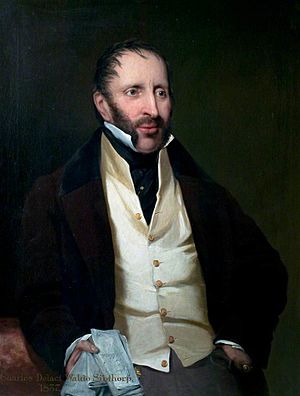Charles Sibthorp facts for kids
Quick facts for kids
Charles Sibthorp
|
|
|---|---|

Portrait of Sibthorp by John Andrews.
|
|
| Member of Parliament for Lincoln | |
| In office 1835–1856 |
|
| Member of Parliament for Lincoln | |
| In office 1826–1832 |
|
| Personal details | |
| Born | 14 February 1783 Lincoln, Great Britain |
| Died | 14 December 1855 (aged 72) London, United Kingdom |
| Political party | Tory/Ultra-Tory |
| Children | Gervaise Waldo-Sibthorp |
| Parent | Humphrey Sibthorp |
| Military service | |
| Allegiance | |
| Branch/service | |
| Years of service | 1803–1822 |
| Rank | Lieutenant-Colonel |
| Unit | 4th Dragoon Guards Scots Greys |
Charles de Laet Waldo Sibthorp (born February 14, 1783 – died December 14, 1855) was a British politician. People often called him Colonel Sibthorp. He was known for his very traditional views. He served as a Member of Parliament (MP) for the city of Lincoln. He was an MP from 1826 to 1832 and again from 1835 until 1855.
Charles Sibthorp was born into a wealthy family in Lincoln. His father was Colonel Humphrey Waldo Sibthorp. Charles joined the army in 1803. He became a Lieutenant in 1806. Later, he became a Captain in the 4th Dragoon Guards. He did not fight in wars abroad. In 1822, he took over his family's estates. He also became a Lieutenant-Colonel in the local army group, the Royal South Lincolnshire Militia. In 1812, he married Maria Tottenham. They had four children together.
A Member of Parliament
Charles Sibthorp was an MP for about 30 years. During this time, he became famous for his very old-fashioned ideas. He was known as one of the most "reactionary" members of Parliament. This means he strongly opposed almost all new ideas and changes.
Opposing New Ideas
Sibthorp was against many important changes happening in Britain.
- He did not support Catholic Emancipation. This was about giving Roman Catholics more rights.
- He also opposed giving Jewish people more rights in England.
- He was against the Reform Act of 1832. This law changed how people voted and gave more people the right to vote.
- He did not want to repeal the Corn Laws. These laws made food expensive for ordinary people.
- He even thought the 1851 Great Exhibition was a bad idea. This was a huge event to show off new inventions and art.
- He believed that new things like railways were just a passing trend. He thought people would soon go back to using "chaises, carriages and stages".
His Strong Opinions
Sibthorp disliked anything he saw as "foreign influence." He even upset Queen Victoria by being suspicious of her husband, Prince Albert. Prince Albert was from Germany.
Because of his strong views and how he spoke his mind, he was often made fun of. He appeared in many funny cartoons in Punch, a famous magazine. He was elected to Parliament eight times in total.
Charles Sibthorp died at his home in London. His son, Gervaise Waldo-Sibthorp, took his place as the MP for Lincoln.
Family Connections
| Sibthorp family tree | |||||||||||||||||||||||||||||||||||||||||||||||||||||||||||||||||||||||||||||||||||||||||||||||||||||||||||||||||||||||||||||||||
|---|---|---|---|---|---|---|---|---|---|---|---|---|---|---|---|---|---|---|---|---|---|---|---|---|---|---|---|---|---|---|---|---|---|---|---|---|---|---|---|---|---|---|---|---|---|---|---|---|---|---|---|---|---|---|---|---|---|---|---|---|---|---|---|---|---|---|---|---|---|---|---|---|---|---|---|---|---|---|---|---|---|---|---|---|---|---|---|---|---|---|---|---|---|---|---|---|---|---|---|---|---|---|---|---|---|---|---|---|---|---|---|---|---|---|---|---|---|---|---|---|---|---|---|---|---|---|---|---|---|
|
|||||||||||||||||||||||||||||||||||||||||||||||||||||||||||||||||||||||||||||||||||||||||||||||||||||||||||||||||||||||||||||||||

